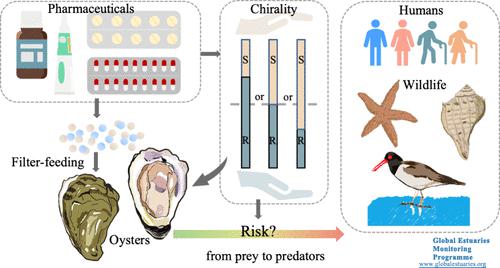当前位置:
X-MOL 学术
›
Environ. Sci. Technol.
›
论文详情
Our official English website, www.x-mol.net, welcomes your feedback! (Note: you will need to create a separate account there.)
Pharmaceutical Residues in Edible Oysters along the Coasts of the East and South China Seas and Associated Health Risks to Humans and Wildlife
Environmental Science & Technology ( IF 11.4 ) Pub Date : 2024-03-13 , DOI: 10.1021/acs.est.3c10588 Rongben Wu, Yan Yin Sin, Lin Cai, Youji Wang, Menghong Hu, Xiaoshou Liu, Wenzhe Xu, Kit Yue Kwan, David Gonçalves, Benny Kwok Kan Chan, Kai Zhang, Apple Pui-Yi Chui, Song Lin Chua, James Kar-Hei Fang, Kenneth Mei-Yee Leung
Environmental Science & Technology ( IF 11.4 ) Pub Date : 2024-03-13 , DOI: 10.1021/acs.est.3c10588 Rongben Wu, Yan Yin Sin, Lin Cai, Youji Wang, Menghong Hu, Xiaoshou Liu, Wenzhe Xu, Kit Yue Kwan, David Gonçalves, Benny Kwok Kan Chan, Kai Zhang, Apple Pui-Yi Chui, Song Lin Chua, James Kar-Hei Fang, Kenneth Mei-Yee Leung

|
The investigation of pharmaceuticals as emerging contaminants in marine biota has been insufficient. In this study, we examined the presence of 51 pharmaceuticals in edible oysters along the coasts of the East and South China Seas. Only nine pharmaceuticals were detected. The mean concentrations of all measured pharmaceuticals in oysters per site ranged from 0.804 to 15.1 ng g–1 of dry weight, with antihistamines being the most common. Brompheniramine and promethazine were identified in biota samples for the first time. Although no significant health risks to humans were identified through consumption of oysters, 100–1000 times higher health risks were observed for wildlife like water birds, seasnails, and starfishes. Specifically, sea snails that primarily feed on oysters were found to be at risk of exposure to ciprofloxacin, brompheniramine, and promethazine. These high risks could be attributed to the monotonous diet habits and relatively limited food sources of these organisms. Furthermore, taking chirality into consideration, chlorpheniramine in the oysters was enriched by the S-enantiomer, with a relative potency 1.1–1.3 times higher when chlorpheniramine was considered as a racemate. Overall, this study highlights the prevalence of antihistamines in seafood and underscores the importance of studying enantioselectivities of pharmaceuticals in health risk assessments.
中文翻译:

东海和南海沿岸食用牡蛎中的药物残留以及对人类和野生动物的相关健康风险
对药物作为海洋生物群中新兴污染物的调查还不够。在这项研究中,我们检测了东海和南海沿岸食用牡蛎中是否含有 51 种药物。仅检测到九种药物。每个部位牡蛎中所有测量药物的平均浓度范围为 0.804 至 15.1 ng g –1干重,其中抗组胺药最常见。首次在生物样本中鉴定出溴苯那敏和异丙嗪。尽管食用牡蛎不会对人类造成重大健康风险,但水鸟、海蜗牛和海星等野生动物的健康风险要高出 100 至 1000 倍。具体来说,主要以牡蛎为食的海螺被发现有接触环丙沙星、溴苯那敏和异丙嗪的风险。这些高风险可能归因于这些生物的单调饮食习惯和相对有限的食物来源。此外,考虑到手性,牡蛎中的扑尔敏被S-对映体富集,当扑尔敏被视为外消旋体时,相对效力高出1.1-1.3倍。总体而言,这项研究强调了海鲜中抗组胺药的普遍存在,并强调了研究药物对映选择性在健康风险评估中的重要性。
更新日期:2024-03-13
中文翻译:

东海和南海沿岸食用牡蛎中的药物残留以及对人类和野生动物的相关健康风险
对药物作为海洋生物群中新兴污染物的调查还不够。在这项研究中,我们检测了东海和南海沿岸食用牡蛎中是否含有 51 种药物。仅检测到九种药物。每个部位牡蛎中所有测量药物的平均浓度范围为 0.804 至 15.1 ng g –1干重,其中抗组胺药最常见。首次在生物样本中鉴定出溴苯那敏和异丙嗪。尽管食用牡蛎不会对人类造成重大健康风险,但水鸟、海蜗牛和海星等野生动物的健康风险要高出 100 至 1000 倍。具体来说,主要以牡蛎为食的海螺被发现有接触环丙沙星、溴苯那敏和异丙嗪的风险。这些高风险可能归因于这些生物的单调饮食习惯和相对有限的食物来源。此外,考虑到手性,牡蛎中的扑尔敏被S-对映体富集,当扑尔敏被视为外消旋体时,相对效力高出1.1-1.3倍。总体而言,这项研究强调了海鲜中抗组胺药的普遍存在,并强调了研究药物对映选择性在健康风险评估中的重要性。



























 京公网安备 11010802027423号
京公网安备 11010802027423号